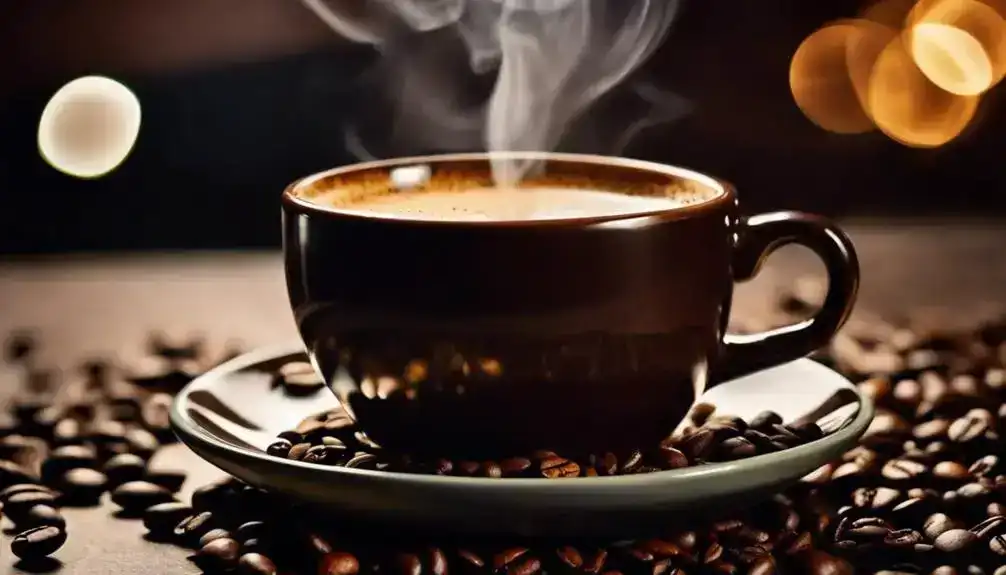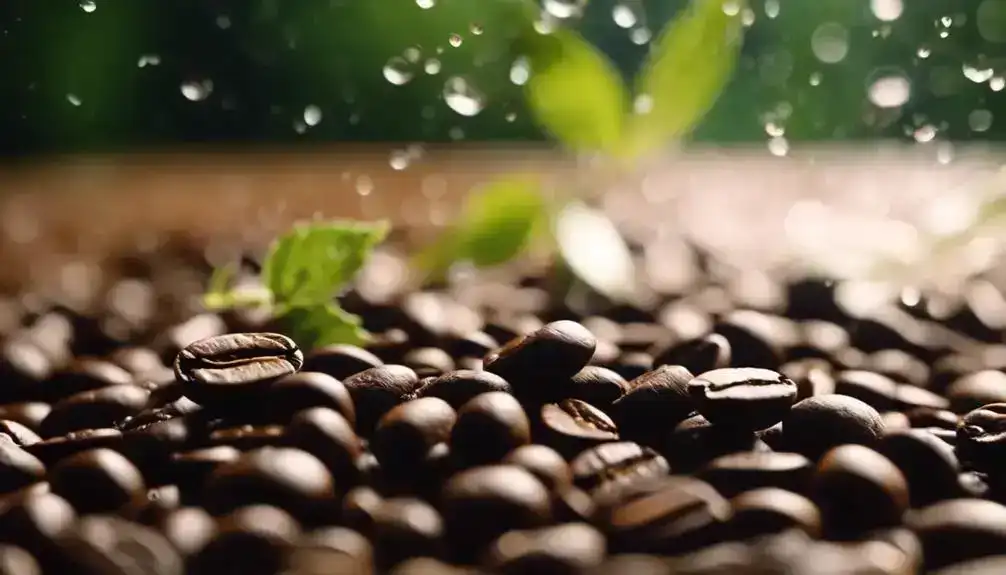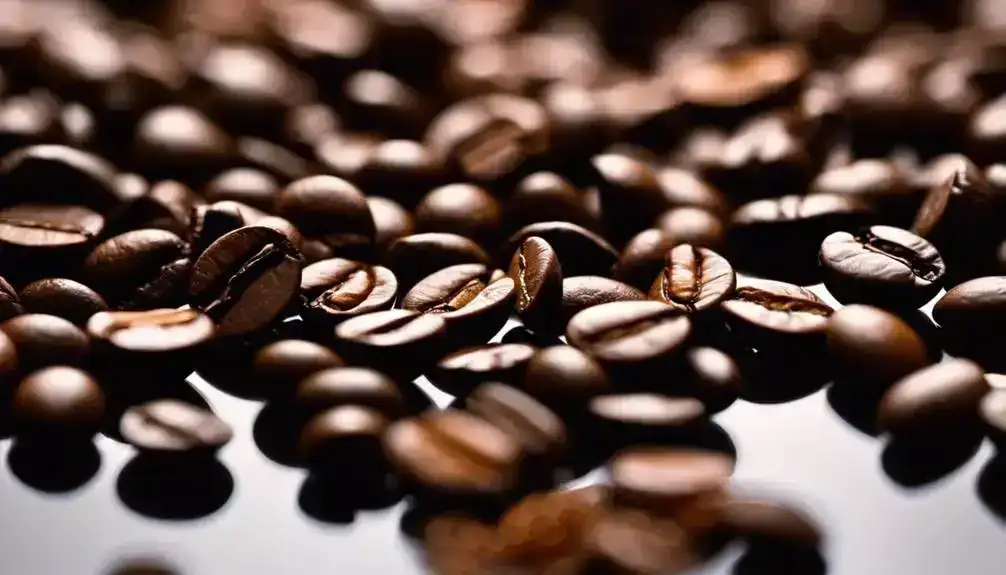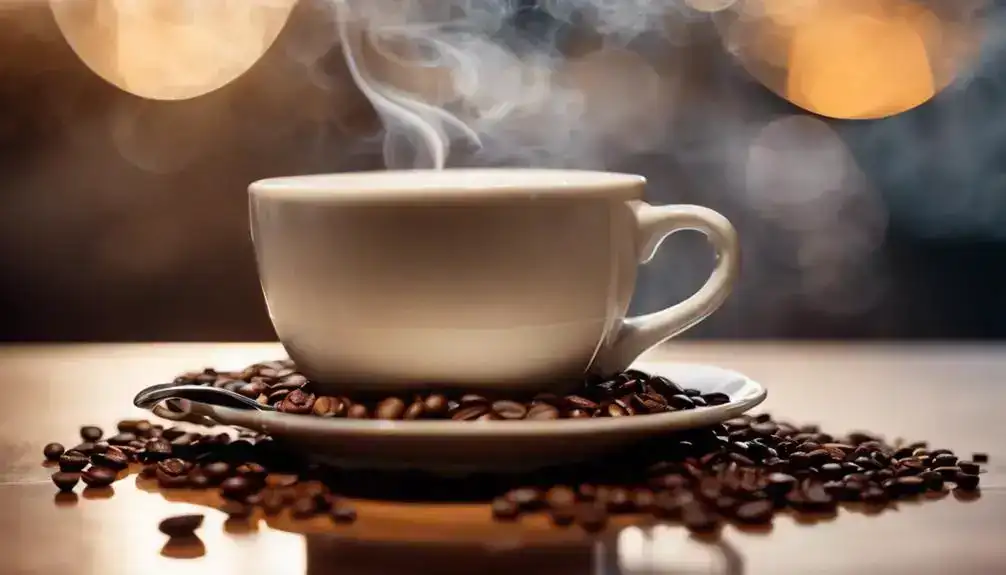In a single 8-ounce cup of decaf coffee, the caffeine content typically ranges between 2 to 15 milligrams. This variation is influenced by different brands and decaffeination methods.
Decaf coffee offers a great option if you’re looking to cut down on caffeine compared to regular coffee. The process of decaffeination guarantees that at least 97% of the caffeine is removed.
If you want to know more about how decaf coffee is made and what factors can affect its caffeine content, keep exploring the details provided.
What is the caffeine content in decaf Coffee?

When exploring the caffeine content in decaf coffee, it’s important to understand that decaf coffee isn’t completely caffeine-free. It contains a reduced amount compared to regular coffee, typically ranging from 2-15 mg per 8-ounce cup.
Different brands and decaffeination processes lead to variations in caffeine levels, making it vital to take these factors into account when choosing decaf coffee for a lower caffeine intake.
Comparing the caffeine content of decaf coffee to regular coffee and other types provides insight into the significant reduction in caffeine, aiding those seeking to manage their caffeine consumption.
General Overview of Caffeine in Decaf Coffee
Decaf coffee contains an average of 2-5 mg of caffeine per 8-ounce cup, falling within a range of 2-15 mg depending on factors like decaffeination process and brewing method.
regulatory standards mandate that decaf coffee must have at least 97% of the caffeine removed from the beans, ensuring a markedly reduced caffeine content compared to regular coffee.
Understanding these average levels, ranges, and standards provides insight into the caffeine content of decaf coffee and its potential effects on your overall caffeine intake.
Average Caffeine Content in Decaf Coffee
The caffeine content in decaf coffee typically ranges from 2 to 5 mg per 8-ounce cup.
- Decaf coffee allows for caffeine reduction in your daily intake.
- Choosing decaf supports your aim of lower caffeine consumption.
- It provides a suitable alternative for those sensitive to caffeine.
- Decaf coffee still offers a flavorful and aromatic experience.
- Enjoy your decaf without worrying about excessive caffeine effects.
Range of Caffeine Levels in Decaf Coffee
Within the domain of decaf coffee, the caffeine levels can vary greatly based on factors like the decaffeination process and brewing techniques.
- Caffeine variations: Range from 2 mg to 15 mg per 8-ounce cup.
- Decaf misconceptions: Include beliefs like decaf being completely caffeine-free.
- Brewing methods: Influence the final caffeine content.
- Brand differences: Result in varying caffeine levels.
- Roasting levels: Impact the caffeine retained in decaf coffee.
Regulatory Standards for Decaf Coffee
Regulatory standards, like those set by the FDA, mandate that decaf coffee must go through a process removing a minimum of 97% of the caffeine content from the beans. This guarantees regulatory compliance and sets caffeine limits for decaf coffee.
Adhering to these standards ensures that decaf coffee maintains lower caffeine levels, making it a suitable choice for those seeking to reduce their caffeine intake.
Specific Examples and Variations in Caffeine Content
When exploring the caffeine content in decaf coffee, examples such as Healthline’s findings, Swiss Water Process data, and Peet’s Coffee insights provide valuable information.
Healthline reports an average of 7 mg of caffeine in decaf coffee, while the Swiss Water Process guarantees caffeine reduction to 2-5 mg per cup.
Peet’s Coffee notes variations in caffeine levels, ranging from 5-10 mg in their decaf blends.
Healthline’s Findings on Decaf Coffee
Healthline’s examination reveals that the average content of caffeine in decaf coffee stands at around 7 mg, although this amount can fluctuate depending on serving size and brewing techniques.
- Health Benefits: Decaf coffee offers a reduced caffeine option.
- Brewing Methods: Different brewing techniques affect caffeine levels.
- Quality Variations: Brands and processes impact caffeine content.
- Serving Size Influence: Larger servings may contain more caffeine.
- Consumer Awareness: Understanding caffeine levels aids informed choices.
Swiss Water Process Caffeine Data
Utilizing the Swiss Water Process guarantees that decaf coffee contains 99.9% less caffeine, resulting in approximately 2-5 mg of caffeine per cup.
- Caffeine extraction methods impact sustainability.
- Decaf coffee plays a role in reducing environmental impact.
- Swiss Water Process prioritizes sustainability.
Environmental impact of decaf coffee production.
- Sustainable practices in decaf coffee industry.
Peet’s Coffee Insights on Decaf Caffeine Levels
Peet’s Coffee guarantees consistency and quality in their decaf offerings, providing valuable insights into the caffeine levels of their decaf coffee blends. They offer a range of approximately 5-10 mg of caffeine per 8-ounce cup, dependent on the specific blend and brewing method.
Different roasting levels can affect caffeine retention.
Lighter roasts may preserve more caffeine but impact flavor.
Specific blends may exhibit varying caffeine content.
Brewing techniques can influence final caffeine levels.
Peet’s ensures consistency and quality in their decaf offerings.
COMPARATIVE ANALYSIS OF CAFFEINE IN DECAF COFFEE:
When comparing caffeine content in decaf coffee to its regular counterpart, various factors come into play, influencing the final caffeine levels. Understanding the differences between decaf coffee and other types such as drip, espresso, and instant coffee sheds light on the significant reduction in caffeine content. Additionally, exploring the caffeine variance between Arabica and Robusta beans used in decaf coffee provides insight into the varying caffeine levels found in different coffee types.
| Regular Coffee vs. Decaf Coffee | Drip Coffee vs. Decaf Coffee | Espresso vs. Decaf Coffee | Instant Coffee vs. Decaf Coffee |
|---|---|---|---|
| Regular coffee has around 95 mg of caffeine per 8-ounce cup, significantly higher than decaf coffee’s 2-15 mg. | Drip coffee typically contains about 95 mg of caffeine per 8-ounce cup, compared to decaf coffee’s much lower caffeine content. | An espresso shot contains approximately 63 mg of caffeine, while decaf espresso contains about 2-5 mg per shot. | Instant coffee generally has around 30-90 mg of caffeine per serving, whereas decaf instant coffee has about 2-5 mg. |
Arabica vs. Robusta: Caffeine in Decaf Coffee Beans:
- Arabica beans: Known for smoother taste with higher acidity levels.
- Robusta beans: Stronger, more bitter flavor profile.
- Roasting techniques: Lighter roasts retain more caffeine.
- Taste differences: Arabica offers a more nuanced flavor.
- Brewing strength: Stronger brews can enhance caffeine extraction.
| Arabica Beans | Robusta Beans |
|---|---|
| Arabica beans, used in decaf coffee, typically have less caffeine than Robusta beans. | Lower caffeine levels are retained in decaf coffee made from Arabica beans compared to those made from Robusta beans. |
Regular Coffee vs. Decaf Coffee: Caffeine Comparison
Decaf coffee stands out from regular coffee due to its significantly lower caffeine content, making it a suitable choice for those seeking to reduce their caffeine intake.
- Decaf coffee provides a caffeine-free alternative.
- Regular coffee offers health benefits due to its caffeine content.
- Decaf coffee is a good option for those with caffeine sensitivity.
- Regular coffee is popular for its energy-boosting properties.
- Decaf coffee allows for consumption later in the day without affecting sleep.
Drip Coffee vs. Decaf Coffee: How They Differ
Comparing drip coffee to decaf coffee reveals a significant disparity in caffeine content, with drip coffee typically containing much higher levels of caffeine per serving.
- Brewing methods: Drip coffee involves hot water passing through ground coffee beans, extracting caffeine.
- Caffeine retention: Decaf coffee goes through a decaffeination process to remove most of its caffeine content.
- Flavor profiles: Drip coffee is known for its robust and bold flavors.
- Taste perception: Decaf coffee offers a milder taste compared to regular drip coffee.
- Caffeine content: Drip coffee generally contains around 95 mg of caffeine per 8-ounce cup.
Espresso vs. Decaf Coffee: Caffeine Levels Compared
In the domain of caffeine content comparison, espresso generally contains around 63 mg of caffeine per shot, contrasting with decaf espresso’s lower range of 2-5 mg per shot.
- Espresso offers a robust flavor profile.
- Decaf espresso goes through a caffeine extraction process.
- The extraction process impacts taste.
- Caffeine levels affect the intensity of the espresso.
- Decaf espresso caters to those seeking a milder option.
Instant Coffee vs. Decaf Coffee: Caffeine Content Analysis
When evaluating the caffeine content between instant coffee and decaf coffee, consider the distinct differences in their respective levels.
- Instant coffee benefits:
- Convenient and quick to prepare.
- Longer shelf life compared to brewed coffee.
- Offers a consistent flavor profile.
- Can be easily adjusted to personal taste preferences.
- Suitable for busy individuals on-the-go.
- Decaf coffee myths:
- Myth: No caffeine in decaf coffee.
Specialty Decaf Blends: Caffeine Content Overview
For a thorough understanding of caffeine content in decaf coffee, let’s explore an overview of specialty decaf blends.
- Flavor profiles: Specialty decaf blends focus on unique and rich flavor profiles.
- Brewing techniques: Different brewing methods are utilized to enhance the flavors of specialty decaf blends.
- Quality standards: Specialty decaf blends maintain high quality while keeping caffeine content low.
- Roasting processes: Roasting techniques impact the final flavor and caffeine levels in specialty decaf blends.
- Origin of beans: The source of coffee beans influences the flavor complexities in specialty decaf blends.
The Decaffeination Process Explained

Understanding the decaffeination process is essential for grasping how most of the caffeine is removed from coffee beans prior to roasting.
Various decaf coffee processes employ methods such as solvent-based extraction, water processing, or supercritical carbon dioxide to extract caffeine.
In the solvent-based method, beans are steamed and then rinsed with a solvent that binds to the caffeine and is subsequently removed.
Water processing involves soaking green coffee beans in water to extract the caffeine, while supercritical carbon dioxide uses high pressure to remove caffeine.
Each method affects the flavor profile and residual caffeine levels differently.
What Factors Influence Caffeine Content in Decaf Coffee?

Factors such as roasting methods, brewing strength, and coffee bean quality play significant roles in determining the caffeine content of decaf coffee.
Lighter roasts tend to retain more caffeine, while brewing strength and the coffee-to-water ratio can influence the final caffeine levels.
Additionally, the origin of the beans and the processing methods used can also impact the amount of caffeine present in decaf coffee.
Impact of Roasting Methods on Caffeine Content
When it comes to decaf coffee, the roasting method plays an essential role in determining caffeine content.
light roast decaf coffee retains more caffeine than its darker counterparts due to the shorter roasting time.
Medium roast strikes a balance between flavor and caffeine levels, while dark roast typically has the lowest caffeine content.
Light Roast Decaf Coffee
Roasting methods play a significant role in determining the caffeine content of light roast decaf coffee. Lighter roasts retain more caffeine due to shorter roasting times, impacting both flavor profiles and brewing techniques.
Factors influencing caffeine levels also include brewing strength, bean quality, and origin variability. Understanding these elements can help you tailor your decaf coffee experience to suit your preferences and caffeine tolerance.
Medium Roast Decaf Coffee
The caffeine content in medium roast decaf coffee is influenced by the duration of the roasting process.
- Lighter roasts retain slightly more caffeine.
- Medium roast offers a balance between flavor and caffeine.
- Dark roast has the least caffeine.
- Roasting impacts flavor profiles.
- Brewing techniques can affect caffeine extraction.
Dark Roast Decaf Coffee
For dark roast decaf coffee, the duration of the roasting process greatly influences the caffeine content, impacting both flavor profiles and caffeine levels.
- Roasting for longer periods results in lower caffeine content.
- Dark roasts offer bold flavors but less caffeine.
Different brewing techniques can alter taste perception.
- The richness of dark roast decaf comes from longer roasting.
- Understanding the roasting process is key to managing caffeine intake.
Brewing Strength and Its Effect on Caffeine Levels
When brewing decaf coffee, the time you steep the grounds, the ratio of coffee to water, and the temperature at which you brew all play an important role in determining the caffeine content.
Longer brewing times tend to extract more caffeine, while a higher coffee-to-water ratio can result in a stronger brew with increased caffeine levels.
Additionally, brewing at higher temperatures can also impact the final caffeine content in your cup of decaf coffee.
How Brewing Time Affects Caffeine in Decaf Coffee
Understanding how brewing time impacts the caffeine content in decaf coffee is crucial for controlling the strength of your brew.
- Longer brewing times can extract more caffeine.
- Shorter brewing times preserve the delicate flavor profiles.
- Adjusting brewing time allows customization of caffeine levels.
- Experimenting with brewing time influences the overall taste experience.
- Consistent brewing times guarantee predictable caffeine content.
The Coffee-to-Water Ratio in Decaf Coffee Brewing
Adjusting the coffee-to-water ratio in decaf coffee brewing plays a significant role in determining the strength of your brew and subsequently affecting the caffeine levels in your cup.
- Water extraction efficiency increases with a higher ratio.
- A well-suited ratio helps in ideal flavor retention.
- Too much coffee can lead to bitterness.
- Too little coffee results in a weak brew.
- Experiment to find your perfect balance.
Brewing Temperature and Caffeine Content
To control the caffeine content in your decaf coffee, consider adjusting the brewing temperature as it directly influences the final caffeine levels in your cup.
- Brewing temperature impacts caffeine levels
- Higher temperatures extract more caffeine
- Affects flavor profiles
- Understanding brewing techniques is essential
- Experimenting with temperatures can alter caffeine content
Quality of Coffee Beans and Caffeine Content
When it comes to the caffeine content in decaf coffee, the quality of coffee beans plays an essential role. Factors like the origin of the beans, processing methods, and the freshness of the beans can all impact the final caffeine levels in your decaf brew.
Understanding these aspects can help you choose decaf coffee that aligns with your caffeine preferences and quality expectations.
Origin of Decaf Coffee Beans
The origin of decaf coffee beans plays a pivotal role in determining the caffeine content after the decaffeination process.
- Different regions offer beans with varying natural caffeine levels.
- Each origin impacts the flavor profile and overall quality of the decaf coffee.
- Quality beans guarantee a better taste and potentially lower residual caffeine.
- Variations in bean type affect caffeine retention post-decaffeination.
- Understanding the origin aids in selecting decaf coffee with desired caffeine levels.
Processing Methods and Their Impact on Caffeine
Processing methods greatly impact the caffeine content in decaf coffee, playing an important role in determining the residual caffeine levels post-decaffeination.
- Flavor Profiles: Different processing methods can influence the flavor profiles of decaf coffee.
- Sustainability Practices: Some decaffeination processes prioritize sustainability, appealing to environmentally conscious consumers.
- Bean Quality: The quality of the coffee beans used can affect the final caffeine content.
- Type of Decaffeination Method: Various decaffeination methods can leave different caffeine traces.
- Ethical Sourcing: Ensuring beans are ethically sourced can impact the overall quality of decaf coffee.
Freshness of Beans and Caffeine Levels in Decaf Coffee
Freshness greatly affects the caffeine levels in decaf coffee, affecting both taste and the effectiveness of the decaffeination process.
- Bean storage
- Roasting effects
- Brewing time influence
- Coffee-to-water ratio impact
- Origin’s caffeine levels
Health and Safety Considerations for Decaf Coffee Drinkers

For decaf coffee drinkers, it’s important to be mindful of the small amounts of caffeine present in decaf coffee, as it can still impact individuals with sensitivity or certain health conditions.
If you’re looking for alternatives with even lower caffeine content, consider herbal teas or caffeine-free beverages.
When it comes to decaf coffee and pregnancy, moderate consumption is generally considered safe, but it’s advisable to consult with your healthcare provider to make sure it aligns with your specific health needs. Pregnant individuals may opt for other caffeine-free options to minimize any potential risks.
Common Myths and Misconceptions about Decaf Coffee

You may have heard myths about decaf coffee that need clarification. Some Common misconceptions include believing decaf coffee has no caffeine, always tastes weak, or undergoes decaffeination after roasting.
Additionally, there are myths surrounding decaf coffee being filled with chemicals or the Swiss Water Process being exclusive to Switzerland.
Let’s debunk these myths and explore the truth behind decaf coffee.
Myth 1: No Caffeine in Decaf Coffee
Despite its name, decaf coffee still contains small amounts of caffeine. One of the common caffeine misconceptions is that decaf coffee is completely caffeine-free, but this isn’t the case.
Decaf coffee typically retains about 2-5 mg of caffeine per 8-ounce cup, although this can vary based on the decaffeination process and brewing method. Regulatory standards mandate that decaf coffee must have at least 97% of the caffeine removed from the beans, but trace amounts still remain.
Different brands and decaffeination processes lead to varying caffeine levels in decaf coffee. Understanding this myth dispels the belief that decaf coffee is entirely caffeine-free and highlights the importance of knowing the actual caffeine content in your cup.
Myth 2: Decaf Coffee Always Tastes Weak
Decaf coffee’s flavor profile can be robust and rich, contrary to the misconception that it always tastes weak. The quality of the beans and the brewing techniques play a significant role in determining the flavor of decaf coffee.
When brewed correctly, decaf coffee can offer a satisfying and flavorful experience, similar to regular coffee. Brewing methods such as the coffee-to-water ratio, brewing time, and brewing temperature influence the final taste of decaf coffee.
Myth 3: Decaffeination Happens After Roasting
Contrary to a common misconception, the decaffeination process occurs before coffee beans are roasted, not after.
Roasting Impact is vital in the decaffeination process as it influences the flavor and chemical composition of the beans.
Post Roast Effects are minimal on the caffeine content since decaffeination happens prior to roasting.
During decaffeination, green coffee beans are treated to remove caffeine, retaining their essential coffee flavors.
The misconception likely arises from the belief that decaffeination occurs after roasting to extract caffeine from the beans.
Understanding that decaffeination precedes roasting helps clarify the process and guarantees that decaf coffee maintains its distinct taste without significant alterations post-roasting.
Myth 4: Decaf Coffee is Full of Chemicals
The belief that decaf coffee is laden with chemicals is a common misconception in the coffee world. In reality, many decaffeination methods focus on producing chemical-free decaf coffee. Processes like the Swiss Water Process use water and natural methods to remove caffeine without the use of harmful chemicals.
These methods guarantee that decaf coffee remains a safe and enjoyable option for those looking to reduce their caffeine intake. Understanding the various decaf misconceptions can help you make informed choices about your coffee consumption.
Myth 5: The Swiss Water Process Only Happens in Switzerland
Many people mistakenly believe that the Swiss Water Process for decaffeinating coffee beans is exclusively conducted in Switzerland. In reality, the Swiss Water Process is a globally recognized method used in various countries worldwide.
This decaffeination technique offers significant benefits, ensuring that decaf coffee retains its flavors without the use of harmful chemicals. The Swiss Water Process involves soaking green coffee beans in hot water to extract caffeine, then passing this water through activated charcoal filters to remove the caffeine while leaving behind the coffee’s essential oils and flavors.
This process results in decaf coffee with approximately 99.9% less caffeine, making it a popular choice among those looking to enjoy coffee without the stimulating effects.
Myth 6: Coffee Roasters Decaffeinate Their Own Coffee
Coffee roasters typically don’t decaffeinate their own coffee, as this process is commonly handled by specialized companies.
Decaffeination is a complex procedure that requires specific equipment and expertise to guarantee the removal of caffeine while preserving the coffee’s flavor profile. Specialized decaffeination companies have the necessary resources and knowledge to execute this process efficiently.
By entrusting decaffeination to these experts, coffee roasters can focus on sourcing high-quality beans, roasting them to perfection, and delivering a flavorful product to consumers. This division of labor allows for a streamlined production process and guarantees that decaf coffee meets the required standards for caffeine content.
Trusting professionals in the decaffeination process ensures that the final product maintains its quality and flavor.
Myth 7: Naturally Decaffeinated Coffee Plants Exist
Naturally decaffeinated coffee plants don’t exist; all coffee plants naturally contain some amount of caffeine. Despite common misconceptions, specialized companies, not nature, are responsible for decaffeinating coffee beans.
Through various decaffeination processes, these companies remove most of the caffeine from the beans to produce decaf coffee. The misconception of naturally decaffeinated coffee plants likely stems from the desire for a caffeine-free option straight from the source.
However, due to the inherent presence of caffeine in coffee plants, the decaffeination process remains an essential step in creating decaf coffee. Understanding this myth dispels the notion of a magical caffeine-free coffee plant and highlights the importance of the decaffeination industry in providing caffeine-reduced coffee options.
Conclusion
So, next time you’re sipping on a cup of decaf coffee, remember that on average, it contains about 2 to 15 mg of caffeine per cup.
Surprisingly, some decaf coffees can contain even less caffeine than some regular brews.
Whether you’re looking to cut back on caffeine or simply enjoy the taste of coffee without the jitters, decaf coffee might just be the perfect option for you.

